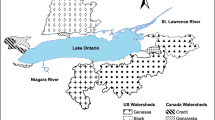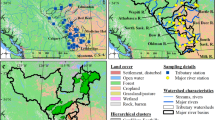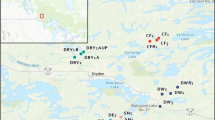Abstract
Although many studies focus on mercury (Hg) and methylmercury (MeHg) dynamics in streams, challenges remain in identifying the relative importance of land cover and seasonality at regulating Hg and MeHg dynamics at the watershed scale. Developing robust proxies for Hg and/or MeHg determination also remains a challenge. Our study used Hg, MeHg, and dissolved organic carbon (DOC) concentration measurements and various DOC fluorescence indices to characterize Hg and DOC dynamics in a forested watershed of the US Northeast. Principal component analysis indicated that land cover/landscape position (i.e., headwater vs. wetland-influenced area vs. lake-influenced area) explained 44 % of the variance in Hg, MeHg, DOC concentrations, and DOC quality during the snow-free season, while seasonality (i.e., air temperature and discharge) explained only 21 % of the variance in the results. Furthermore, finding a good proxy for Hg that is valid across a range of landscape positions remains a challenge; however, regression analysis indicated that the fluorescence peak Humic C (excitation = 350 nm; emission = max (420–480)), which corresponds to the presence of melanoidins in water, explained 21 % of the variability in MeHg concentrations across both space and time (p = 0.001), and thus appears to be a possible proxy for MeHg determination in our study watershed. From a management perspective, land cover modifications (lake, reservoir, and wetland) are likely to play more important roles at regulating Hg, MeHg, and DOC exports at the watershed scale than long-term changes in the climate of this region.







Similar content being viewed by others
References
Allan, C. J., & Heyes, A. (1998). A preliminary assessment of wet deposition and episodic transport of total and methyl mercury from low order Blue Ridge Watersheds, S.E. U.S.A. Water, Air, and Soil Pollution, 105, 573–592. doi:10.1023/A: 1004971824366.
Allan, C. J., Heyes, A., Roulet, N. T., St. Louis, V. L., & Rudd, J. W. M. (2001). Spatial and temporal dynamics of mercury in precambrian shield upland runoff. Biogeochemistry, 52, 13–40. doi:10.1023/A:1026543418120.
Babiarz, C. L., Benoit, J. M., Shafer, M. M., Andren, A. W., Hurley, J. P., & Webb, D. A. (1998). Seasonal Influences on partitioning and transport of total and methylmercury in rivers from contrasting watersheds. Biogeochemistry, 41, 237–257. doi:10.1023/A:1005940630948.
Bishop, K. H., Lee, Y. H., Pettersson, C., & Allard, B. (1995). Terrestrial sources of methylmercury in surface waters: the importance of the riparian zone on the Svartberget Catchment. Water, Air, and Soil Pollution, 80, 435–444. doi:10.1007/BF01189693.
Branfireun, B. A., & Roulet, N. T. (2002). Controls on the fate and transport of methylmercury in a boreal headwater catchment, Northwestern Ontario, Canada. Hydrology and Earth System Sciences, 6, 785–792.
Bushey, J. T., Driscoll, C. T., Mitchell, M. J., Selvendiran, P., & Montesdeoca, M. R. (2008). Mercury transport following storm events from a northern forest landscape. Hydrological Processes, 22, 4813–4826.
Coble, P. G. (1996). Characterization of marine and terrestrial DOM in seawater using excitation-emission matrix spectroscopy. Marine Chemistry, 51, 325–346.
Cory, R. M., McKnight, D. M., (2005). Fluorescence spectroscopy reveals ubiquitous presence of oxidized and reduced quinones in dissolved organic matter. Environmental Science and Technology 39, 8142–8149.
Dittman, J. D., Shanley, J. B., Driscoll, C. T., Aiken, G. R., Chalmers, A. T., & Towse, J. E. (2009). Ultraviolet absorbance as a proxy for total dissolved mercury in streams. Environmental Pollution, 157, 953–1956. doi:10.1016/j.envpol.2009.01.031.
Dittman, J. A., Shanley, J. B., Driscoll, C. T., Aiken, G. R., Chalmers, A. T., Towse, J. E., & Selvendiran, P. (2010). Mercury dynamics in relation to dissolved organic carbon concentration and quality during high flow events in three northeastern U.S. streams. Water Resources Research, 46, W07522.
Downing, B. D., Boss, E., Bergamaschi, B. A., Fleck, J. A., Lionberger, M. A., Ganju, N. K., Schoellhamer, D. H., & Fujii, R. (2009). Quantifying fluxes and characterizing compositional changes of dissolved organic matter in aquatic systems in situ using combined acoustic and optical measurements. Limnology and Oceanography: Methods, 7, 119–131.
Driscoll, C., Han, T., Chen, Y. J., Ever, C. Y., Lambert, D. C., Holsen, K. F., Kamman, T. M., Munson, N. C., & Ronald, K. (2007). Mercury contamination in forest and freshwater ecosystems in the northeastern United States. American Institute of Biological Sciences, 57(1), 17–28.
EPA, 2007. United States Environmental Protection Agency (USEPA), 2005⁄2006 National listing of fish advisories. USEPA Fact Sheet EPA-823-F-07-003. USEPA, Washington, D.C., 7pp
Ertel, J. R., & Hedges, J. I. (1983). Bulk chemical and spectroscopic properties of marine and terrestrial humic acids, melanoidins and catechol-based synthetic polymers. In R. F. Christman & E. T. Gjessing (Eds.), Aquatic and Terrestrial Humic Materials (pp. 143–163). Ann Arbor, MI: Ann Arbor Sci.
Fellman, J. B., Hood, E., D’Amore, D. V., Edwards, R. T., & White, D. (2009). Seasonal changes in the chemical quality and biodegradability of dissolved organic matter exported from soils to streams in coastal temperate rainforest watersheds. Biogeochemistry. doi:10.1007/s10533-009-9336-6.
Hammer, O., Harper, D.A.T, Ryan, P.D. (2001) PAST: Paleontological Statistics Software Package for Education and Data Analysis. Palaeontologia Electronica, 4(1), 9 pp., http://palaeo-electronica.org/ 2001_1/past/issue1_01.htm, Accessed July 2006.
Hood, E., Gooseff, M. N., & Johnson, S. S. (2006). Changes in the character of stream water dissolved organic carbon during flushing in three small watersheds, Oregon. Journal of Geophysical Research, 111, G01007. doi:10.1029/2005JG000082.
Inamdar, S., Finger, N., Singh, S., Mitchell, M., Levia, D., Bais, H., Scott, D., & McHale, P. (2011). Dissolved organic matter (DOM) concentration and quality in a forested mid-Atlantic watershed USA. Biogeochemistry. doi:10.1007/s10533-011-9572-4.
Kolka, R. K., Grigal, D. F., Verry, E. S., & Nater, E. A. (1999). Mercury and organic carbon relationships in streams draining forested upland ⁄ peatland watersheds. Journal of Environmental Quality, 28, 766–775.
McKnight, D. M., Boyer, E. W., Westerhoff, P. K., Doran, P. T., Kulbe, T., & Andersen, D. T. (2001). Spectrofluorometric characterization of dissolved organic matter for indication of precursor organic material and aromaticity. Limnology and Oceanography, 46(1), 38–48.
Mitchell, C. P. J., Branfireun, B. A., & Kolka, R. A. (2008). Spatial characteristics of net methylmercury Production hot spots in peatlands. Environmental Science and Technology, 42, 1010–1016. doi:10.1021/es0704986.
Mitchell, M.J., Raynal, D.J., Driscoll, C.T. (2009). Response of Adirondack ecosystems to atmospheric pollutants and climate change at the Huntington forest and Arbutus watershed: research findings and implications for public policy. Synthesis Report. New York State Energy Research and Development Authority (NYSERDA), Albany, New York.
Ohno, T. (2002). Fluorescence inner-filtering correction for determining the humification index of dissolved organic matter. Environmental Sciences and Technology, 36, 742–746.
Park, J., Mitchell, M. J., & Driscoll, C. T. (2005). Winter-time climatic control on dissolved organic carbon export and surface water chemistry in an Adirondack forested watershed. Environmental Science and Technology, 39, 6993–6998.
Saraceno, J. F., Pellerin, B. A., Downing, B. D., Boss, E., Bachand, P. A. M., & Bergamaschi, B. A. (2009). High frequency in situ optical measurements during a storm event: assessing relationships between dissolved organic matter, sediment concentration and hydrologic processes. Journal of Geophysical Research, 114, G00F09. doi:10.1029/2009JG000989.
Selvendiran, P., Driscoll, C. T., Montesdeoca, M. R., Choi, H.-D., & Holsen, T. M. (2009). Mercury dynamics and transport in two Adirondack lakes. Limnology and Oceanography, 54, 413–427.
Shanley, J. B., Kamman, N. C., Clair, T. A., & Chalmers, A. (2005). Physical controls on total and methylmercury concentrations in streams and lakes of the Northeastern USA. Ecotoxicology, 14, 125–134. doi:10.1007/s10646-004-6264-z.
Shanley, J. B., Mast, M. A., Campbell, D. H., Aiken, G. R., Krabbenhoft, D. P., Hunt, R. J., Walker, J. F., Schuster, P. F., Chalmers, A., Aulenbach, B. T., Peters, N. E., Marvin-DiPasquale, M., Clow, D. W., & Shafer, M. M. (2008). Comparison of total mercury and methylmercury cycling at five sites using the small watershed approach. Environmental Pollution, 154, 143–154. doi:10.1016/j.envpol.2007.12.031.
Sinclair, K. A., Xie, Q., & Mitchell, C. P. J. (2012). Methylmercury in water, sediment, and invertebrates in created wetlands of Rouge Park, Toronto, Canada. Environmental Pollution, 171, 207–215.
Sommers, R.C. (1986) Soil classification, genesis, morphology, and variability of soils found within the central Adirondack region of New York. State University of New York College of Environmental Science and Forestry, Syracuse NY (thesis).
St. Louis, V. L., Rudd, J. W. M., Kelly, C. A., Beaty, K. J., Flett, R. J., & Roulet, N. (1996). Production and loss of methylmercury and loss of total mercury from boreal forest catchments containing different types of wetlands. Environmental Science and Technology, 30, 2719–2729.
Todorova, S. G., Driscoll, C. T., Matthews, D. A., Effler, S. W., Hines, M. E., & Henry, E. A. (2009). Evidence for regulation of monomethyl mercury by nitrate in a seasonally stratified, eutrophic lake. Environmental Science and Technology, 43, 6572–6778.
Vidon, P., Allan, C., Burns, D., Duval, T. P., Gurwick, N., Inamdar, S., Lowrance, R., Okay, J., Scott, D., & Sebestyen, S. (2010). Hot spots and hot moments in riparian zones: potential for improved water quality management. Journal of the American Water Resources Association, 46(2), 278–298.
Vidon, P., Carleton, W., Mitchell, M. (2014) Spatial and temporal variability in stream dissolved organic carbon quantity and quality in an Adirondack forested catchment. Applied Geochemistry, 46, 10–18, doi: http:// dx.doi.org/10.1016/j.apgeochem.2014.04.008.
Yamashita, Y., & Tanoue, E. (2004). Chemical characteristics of amino acid-containing dissolved organic matter in seawater. Organic Geochemistry, 35, 679–692.
Zimmer, M., & Lautz, L. (2013). Temporal and spatial response of hyporheic zone geochemistry to a storm event. Hydrological Processes. doi:10.1002/hyp.9778.
Acknowledgments
This project was supported by a grant from the US Geological Survey 104B grant program through the New York Water Resources Institute (Award no. 64038-9616) to P. Vidon and M. Mitchell. Its contents are solely the responsibility of the authors and do not necessarily represent the official views of the USGS. The authors would like to thank Pat McHale and Mario Montesdeoca for help in the field and laboratory.
Author information
Authors and Affiliations
Corresponding author
Rights and permissions
About this article
Cite this article
Vidon, P., Carleton, W. & Mitchell, M.J. Mercury proxies and mercury dynamics in a forested watershed of the US Northeast. Environ Monit Assess 186, 7475–7488 (2014). https://doi.org/10.1007/s10661-014-3941-0
Received:
Accepted:
Published:
Issue Date:
DOI: https://doi.org/10.1007/s10661-014-3941-0




